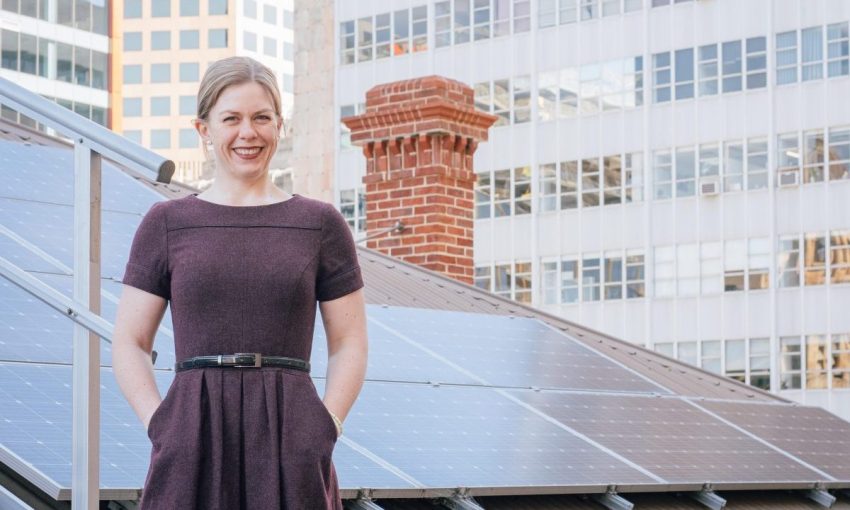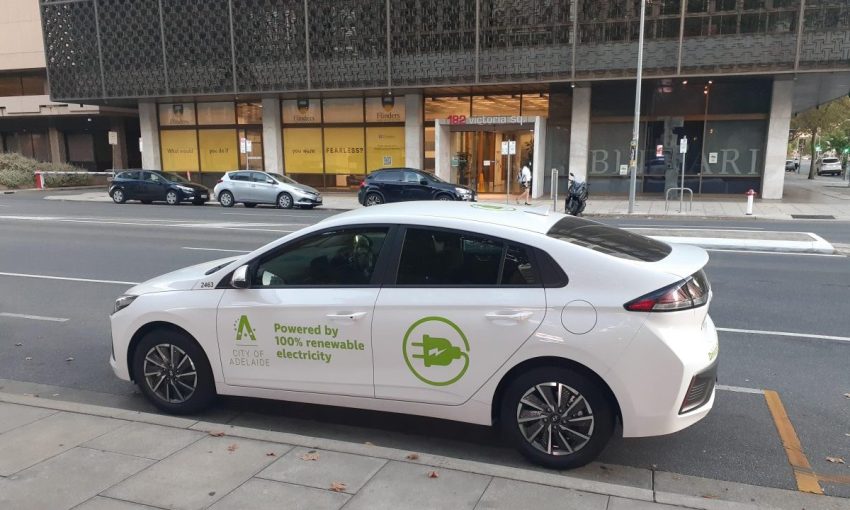If you could see a person’s ‘carbon shadow’, the one attached to City of Adelaide’s Andrea Bassett might just manifest as outstretched arms around the world.
A day in the life: Andrea Bassett
The City of Adelaide has a long history of leadership in addressing climate impacts, including having its own operations certified carbon neutral since 2020.
At the end of 2023, the City endorsed a new draft Integrated Climate Strategy for public consultation, which sets bigger, bolder ambitions for how it will address climate change out to 2030. The strategy seeks to put emphasis on how Council services can help further reduce the city community’s impact on climate change and ensure the city is resilient, liveable and thriving in a changing environment.
As principal climate change advisor in City of Adelaide’s low carbon and circular economy team, Andrea Bassett spends her days influencing others.
Not as a stalk-the-corridors-lobbyist in Parliament House, or in a US Congress I-can-give-you-a-campaign-contribution kind of way. But in what nudge theory proponents call ‘shaping the environment’ to encourage a desired outcome.
If you’ve noticed the City’s streets becoming greener, it’s not only because it looks prettier. It could help give alternatives to driving and keep streets cool.
Andrea’s stance on how the Council can help others reduce their impact on the climate is holistic. “We want to provide the community with the biggest spread of low carbon options, so that they can choose the one that suits them.
“Of course, this means things like providing cycling and walking infrastructure, as well as trees for shade, and support for locals to ‘decarbonise’ their business or home life.”
They’re also supporting the transition to electric vehicles, rolling out EV chargers on-street and in UPark carparks, and advocating to the State Government for improved public transport and zero emissions public transport.
“We take the approach of everything, everywhere, all at once when it comes to low carbon transport,” says Andrea, who’s been with the City for two years, but working in the environmental sector her whole life.
She explains that a ‘carbon shadow’ acknowledges the impact one has by talking to and influencing others to reduce their carbon footprints.
Unlike a carbon footprint, it’s difficult to accurately measure. However, her own and her employer’s would cast long.
“It’s what we look at as a city,” she says. “Adelaide is small on a global scale. But that means we can be bold, ambitious, and maybe take risks and find opportunities. If they work, we can share those learnings further out and really amplify our impact.”
In a highly practical sense, there is also a wide range of incentives for residents and businesses to electrify, install energy smart appliances or solar. At the moment, the push is to replace gas appliances with electrical ones, with a cash rebate to encourage wider uptake.
“One of the real privileges of my job is being able to support residents and small businesses, like cafés, to make these changes that will help them reduce their electricity bills and be more comfortable,” she says.
Andrea’s day to day focus ranges from this, the hyperlocal, to global.
“One moment I might be having a discussion about the most efficient type of air conditioning and what refrigerant gases we should be using. And then the next minute, I’ll be on a call with colleagues in Vancouver, hearing about how they’re incorporating equity and justice into their response to climate change.
“It’s hugely varied [and] really fascinating. You have to do a lot of research, stay on top of the news and really keep your eyes open to what’s happening in the climate change world.”
Growing up on a sheep and cattle farm in Inverell in northern New South Wales, from a very young age she had a keen interest in preserving the land and supporting the environment.
That led to environmental science and law degrees in Sydney, and a masters in environmental law in Vancouver. She’s worked across a wide range of industries, including environmental social governance (ESG) investing in Scotland, before moving to Adelaide four years ago.
Andrea recently attended COP28, the 2023 United Nations Climate Change Conference held in Dubai, as part of a Melbourne Centre for Cities delegation, funded by the Department of Foreign Affairs and Trade.
International connections like this help bring proven, new global solutions to Adelaide. “All cities are different, with different contexts and different issues that they’re battling,” Andrea says. “But there’s a lot we can learn from each other.”
“In South Australia, we have that huge advantage of the world’s best renewable electricity grid. No other grid of this size has as much wind and solar in it – we’re really leading the way. As a city, we can help capitalise on that opportunity by supporting businesses and residents to convert their vehicles, cooking and heating to be powered by that electricity.”
The biggest impact climate change will have on Adelaide is extreme heat and heat waves, and Andrea says we need to find ways of living with climate change while we’re still working to slow it down.
“One of the most effective ways of doing that is through urban greening. It’s not necessarily just trees, but it’s more vegetation around the city,” she explains.
Greening has a real and immediate cooling impact on the land area around it. The Adelaide Park Lands can be up to 8°C cooler than built up areas.
“But the effects don’t necessarily reach all the way into the city. We need to focus on greening on our city streets as well,” she adds.
It’s an all-hands-on-deck approach at the City, with many different teams working on climate related issues. Other colleagues have undertaken projects to trial innovations, such as reflective paint on roads and rooftops to reduce heat absorption. A recent Cool Roof trial with the University of Adelaide found the temperature of a dark roof could be reduced up to 17°C, and provide an indoor temperature 4-8°C lower than the outside.
A Cool Road project, delivered by Climate KIC Australia and in partnership with the South Australian Department for Environment and Water, found heat-reflective coatings reduced the road temperature by up to 8.65°C during the day and 4.2°C at night.
The City is looking at how it can incorporate these findings into regular operations, as Andrea explains.
“Addressing climate change can, and should, be done in a way that also makes the city a better place to live, work, study and play. For example, supporting more of those low carbon transport options so people can move about the city conveniently, and finding new economic opportunities for local, sustainable industries.”
It meshes well with why she made the change from the corporate world and ESG investing to council.
“It was the opportunity to create real, tangible benefits for our community. But it’s really about being able to act locally, while having a global mindset about the problem.
“And I think there’s a lot of learnings that can be shared back and forth between local government and the corporate sector – and they’re not as different as they might appear.”







